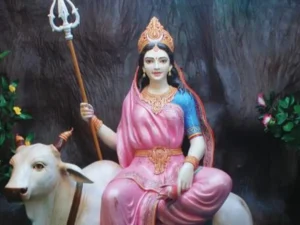Navratri: The Divine Saga of Nine Nights and Their Profound Significance
Navratri, the festival of nine nights, holds a special place in the hearts of millions of Hindus across the world. This vibrant and spiritually charged festival celebrates the nine forms of the Hindu Goddess Durga, symbolizing her various manifestations and attributes. Each day of Navratri is dedicated to one of these forms and carries deep significance.
In this blog, we will take a journey through the nine days of Navratri, exploring the stories, rituals, and the spiritual importance associated with each day. These nine nights are a time for fasting, prayers, dance, and devotion, as people seek the blessings of the divine and celebrate the victory of good over evil.
Day 1: Pratipada – Shailaputri
Navratri begins with the worship of Goddess Shailaputri, the daughter of the King of the Mountains. She symbolizes the power of the earth and is a source of strength and purity. On this day, devotees pray for the removal of impurities and obstacles in their lives.
Day 2: Dwitiya – Brahmacharini
The second day of Navratri is dedicated to Goddess Brahmacharini, the ascetic form of Parvati. She represents spiritual wisdom and knowledge. Devotees seek her blessings for inner strength and self-discipline.
Day 3: Tritiya – Chandraghanta
Goddess Chandraghanta, the form worshipped on the third day, is known for her bravery and protection. She wears a half-moon bell on her forehead, symbolizing the removal of evil. Devotees seek her blessings for courage and safety.
Day 4: Chaturthi – Kushmanda
Goddess Kushmanda, the creator of the universe, is the focus of the fourth day. She is associated with the cosmic egg and is believed to provide energy and strength to her devotees.
Day 5: Panchami – Skandamata
On the fifth day, devotees worship Goddess Skandamata, the mother of Lord Skanda (Kartikeya). She symbolizes motherly love and nurturance. Her blessings are sought for the well-being of children.
Day 6: Shashti – Katyayani
Goddess Katyayani is the sixth form of Navadurga and is revered for her fierce aspect. She is believed to provide strength and protection against evil forces. Devotees pray for strength and courage on this day.
Day 7: Saptami – Kalaratri
The seventh day is dedicated to Goddess Kalaratri, a fierce and destructive manifestation of Durga. Devotees seek her blessings to remove fear and darkness from their lives.
Day 8: Ashtami – Mahagauri
Goddess Mahagauri, the epitome of purity and serenity, is worshipped on the eighth day. She brings peace and calmness into the lives of her devotees.
Day 9: Navami – Siddhidatri
On the ninth and final day of Navratri, Goddess Siddhidatri is venerated. She is the giver of supernatural powers and blessings. Devotees pray for spiritual enlightenment and divine wisdom on this auspicious day.
Conclusion
Navratri is a time of spiritual reflection, devotion, and celebration. The nine nights of this festival symbolize the victory of good over evil, and they hold profound significance for Hindus. It is a time when people come together, fast, dance, and celebrate the divine manifestations of the Goddess Durga.
The tenth day of Navratri, known as Vijayadashami or Dussehra, marks the culmination of this festival and the triumph of righteousness. It is the day when Lord Rama defeated the demon king Ravana, showcasing the ultimate victory of good over evil.
Navratri is a festival of color, culture, and spirituality, and it reminds us of the eternal fight between darkness and light, ignorance and wisdom. It is a time to seek the blessings of the divine, strengthen our inner selves, and revel in the joyous festivities that unite communities in the worship of the divine Mother Goddess.










